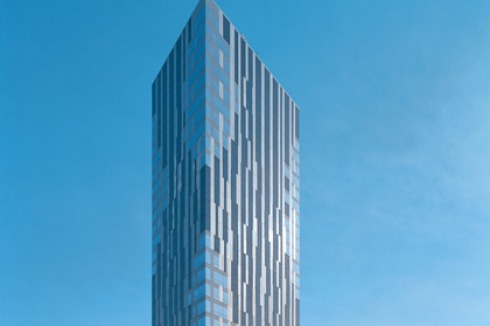Luxury for all?
Afforable Housing in New York
Text: Spertus, Juliette, Brooklyn
-

-

Still: from a Video by Downtown Brooklyn Partnership, 2006
Still: from a Video by Downtown Brooklyn Partnership, 2006
The Toren residential tower by Skidmore, Owings & Merrill exemplifies a market segment that has transformed Downtown Brooklyn over the past decade. By including affordable housing in luxury projects, developers and condominium buyers gain financial advantages—but what does this arrangement offer the city?
I used to know that I had arrived in New York City when I saw brick housing towers file past in rows from the expressway. These superblocks, built as various forms of low- and middle-income dwellings into the 1960s, constitute only a small part of the city’s housing stock. But the scale and the ubiquitous red brick, punctuated by pairs of small double-hung windows, announced: Here is New York.
Fast forward ten years. If I think of a single housing typology that epitomizes New York City today, it is the luxury condo: glass and steel residential towers up to 40 floors high, clustering in former industrial areas like the Far West Side of Manhattan or the Brooklyn-Queens waterfront, areas that were rezoned for high-rise residential and commercial development over the last ten years. Downtown Brooklyn, the city’s third largest business district after Midtown and the Financial District in Manhattan, was rezoned in 2001. The City Council approved a “Special Downtown Brooklyn District” to stimulate investment in an area that, despite the economic and construction boom of the 1990s, was characterized by parking lots and aging government and commercial buildings unchanged since urban renewal efforts stalled in the 1970s. The plan allows for a variety of commercial, entertainment, and residential uses; residential zoning was changed to R10 (highrise), ultimately envisioning 35,000 new residents. The rezoning brought the borough some of its first luxury residential towers with over two thousand apartments in Downtown Brooklyn to date.
The luxury condo does not, at first glance, seem to have anything to do with brick superblocks for low-income residents. But it turns out that many of the new high-rises incorporate income-restricted housing. The 37-story Toren (Dutch for “tower”) is perhaps the most architecturally striking of the new high-rises rapidly changing the face of Flatbush Avenue in Downtown Brooklyn. It was designed by architect Roger Duffy of Skidmore, Owings & Merrill (SOM) for developer BFC Partners. Of the 240 units, 40 are income-restricted. Why would developers incorporate these units in their project?
In the late 1960s, as the city was experiencing rapid population loss, a new tax law was written to stimulate residential construction. Between 1971 and 1987 every residential development in New York was eligible for a 421a tax abatement, or the right to continue paying taxes on the pre-construction value of a property for up to 25 years. By 1987 the housing market in mid-Manhattan had recovered and the tax abatement was removed from that area. The general housing subsidy has since been repurposed to preserve affordable units and economic diversity in high-rent and gentrifying neighborhoods. Most of Manhattan and the wealthier parts of the outer boroughs are “geographic exclusion zones.” Here developers have to set aside 20 percent of the units for families earning 60 percent of Area Median Income (AMI) to qualify for the 421a tax abatement. Downtown Brooklyn has been an “exclusion zone” since 2008. There is no affordable housing requirement outside of these zones, but developers can qualify for addition-al tax benefits if they set aside the required number of afford-able units. Critics point out that the city loses millions of dollars in taxes through the 421a program – $911.6 million in 2011 alone – for a relatively small number of affordable units created. Critics also note that units generally stay affordable for only 35 years, after which restrictions are lifted.
Tax policy: progressive or wasteful?
In 2008, the City also applied a complementary planning in-strument called the Inclusionary Housing Program to Downtown Brooklyn. Under this program, developers generally receive a 33 percent floor area bonus if they set aside 20 percent of the units for low-income households (up to 80 percent of AMI). In the first iterations of the program, created in 1987, developers often chose to build the affordable units off-site in a less costly part of the city. In 2005, the City required developers to distribute these apartments within the project itself and equip them to the same standards as the market-rate units. Here, too, critics point to the inadequate number of units produced compared to programs in other high-cost cities such as Boston which require including affordable units in all developments above a certain size. Advocates emphasize that the units stay permanently income-restricted and that the program, at least in theory, does not cost the city anything. (In practice, the floor area bonus is frequently accompanied by further subsidies for the affordable units.)
The Toren’s affordable housing was not the result of ei-ther of these programs in their current versions. BFC Partners broke ground in 2007, several months before the 421a rules were updated and the City made Downtown Brooklyn an exclusion zone. Under the old 421a rules, the Toren was already eligible for extended 421a tax benefits because it received significant government assistance (SGA) in the form of a grant for a combined heat and power (CHP) plant. The City required BFC Partners to include affordable units in the Toren in exchange for allowing BFC to purchase adjacent publicly owned land at below market value. Since the affordable units were not set aside as part of a specific housing program, BFC Partners was able to negotiate a relatively high 175 percent AMI income restriction, which translates to approximately $140,000 annually for a family of four. Under the current 421a rules, 20 percent of the units in an SGA project like the Toren would have to be set aside at 125 percent AMI.
Property taxes constitute the largest part of a condo buyer’s ongoing housing costs, so advertising 421a status helps developers sell apartments. The ultimate impact of 421a on the Toren is not clear, however. It was one of the best selling towers of 2010, but it is still not fully occupied. Despite a huge demand for the affordable housing – the building’s forty units drew two thousand applicants when it went on the market in 2008, at the height of the financial crisis – a number of the apartments did not sell because City-approved buyers could not find financing. In a gesture to neighborhood groups, applicants who were long-time residents of the district, municipal employees, police officers, or individuals with disabilities were given priority. Without City-approved buyers, the re-maining affordable units were sold on a first come, first served basis to anyone who met the income requirements and could get a loan.
Many observers consider it economically wasteful to subsidize units in buildings with concierge services and swimming pools. For architect Duffy, this is precisely what makes the tax incentives and inclusionary housing so progressive: “There is no class distinction. All residents share the same lobby and ride in the same elevators. In contrast to the social engineering of the 1960s, there is no separation between different income levels.”
Upstairs, downstairs
The Toren’s floor plans tell a slightly different story: all of the affordable units are concentrated in the base and differ in size and finishes from those in the tower above. The Toren did not have to meet the requirement of evenly distributing the units throughout the building because it was not part of the Inclu-sionary Housing Program. Perhaps more detrimental to the goal of ensuring economic diversity in a gentrifying neighborhood, the Toren provides only studios, one- and two-bedroom apartments as affordable housing, too small for families with more than one child. Three-bedroom units are available as penthouse duplexes. Income levels may be mixed (if you consider an annual income of $140,000 as a fair point of departure for the mix), but if household sizes are all the same, what demographic diversity can result? With its curtain wall façade, the Toren certainly stands out from the other luxury towers nearby. The idea of using views to generate the architecture from the unit layouts to the exterior detailing was consistently well implemented. This makes it all the more disappointing that the views, marketed as being so central to the Toren’s concept, cannot actually be shared by its residents.
Roger Duffy ended our conversation with an anecdote about raising his own family in Stuyvesant Town, the 8,757-unit middle-income housing development in lower Manhattan built by the Metropolitan Life Insurance Company in the 1940s. “The buildings themselves are very plain Jane and repetitive and brick. But the amount and quality of the green space in between, the pathways, the playgrounds, the parks make the project so attractive. A lot of the early housing projects relied on that kind of strategy and did not put all of the heat on the architecture to do the work.”
Note: In the original German version of this text, the Toren‘s 421a tax benefits were attributed to the incorporation of affordable units in the building. This error been corrected in this English version.
x
Bauwelt Newsletter
Immer freitags erscheint der Bauwelt-Newsletter mit dem Wichtigsten der Woche: Lesen Sie, worum es in der neuen Ausgabe geht. Außerdem:
- » aktuelle Stellenangebote
- » exklusive Online-Beiträge, Interviews und Bildstrecken
- » Wettbewerbsauslobungen
- » Termine
- » Der Newsletter ist selbstverständlich kostenlos und jederzeit wieder kündbar.
Beispiele, Hinweise: Datenschutz, Analyse, Widerruf
0 Kommentare